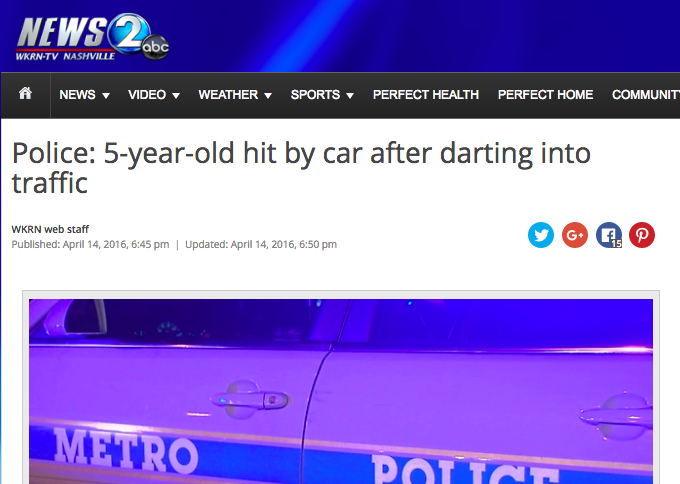Each year, motorists on American streets kill nearly 5,000 pedestrians. The loss of life is enormous -- equivalent to 12 jumbo jets crashing with no survivors -- but the steady drumbeat of pedestrian fatalities doesn't register as an urgent public safety crisis. Maybe it would seem more urgent if the press covered pedestrian deaths as the preventable outcome of a broken system, instead of a series of random "accidents."

Most local media reports of pedestrian deaths are just a few sentences long. In that brief space, they still manage to trivialize the issue of pedestrian safety and gloss over the underlying causes of traffic fatalities.
Here are four common problems with how pedestrian deaths are covered in American media and why reporters need to change their approach to traffic violence.
Blaming the victim
The default stance of most coverage is to blame victims for their own deaths. Maybe the reporter will note that the victim was not in a crosswalk, or jaywalking, or reportedly "darted" into traffic.
The underlying message is the same: If only the victim had followed the rules, he or she would still be alive. What never seems to get much scrutiny is how the driver's actions could have prevented the fatal collision -- by traveling at a safe speed, for instance, or just driving attentively on a busy city street.
In reporters' defense, crash information tends to come directly from flawed police reports that reflect a survivor's bias.
These reports are often based on a single eyewitness -- the driver who hit the victim. Depending on a witness who is potentially culpable for killing someone cannot produce a trustworthy account. Nevertheless, the driver's version of events is often repeated by police, becoming the basis for local news stories.
Failure to consider street conditions

Most local news reports entirely ignore the design of the street where the collision happened. But the epidemic of pedestrian deaths can't be separated from street conditions.
More than half of all pedestrian deaths occur on multi-lane arterial roads. Wide streets flanked by destinations that people walk to -- like apartment buildings and commercial development -- are particularly deadly, according to a report by Transportation for America.
In fact, as cities dig into the data, stark patterns often emerge. Pedestrian fatalities are often concentrated on just a few streets. In San Jose, for example, 50 percent of traffic fatalities occur on just 3 percent of streets. And nationwide, dangerous corridors tend to be concentrated in low-income areas.
By treating pedestrian deaths as isolated occurrences, reporters fail to convey critical information about where people are at risk and how fatalities can be prevented in the future.
Talking about cars, not drivers
When reporters describe traffic crashes, they often center the car or vehicle rather than the driver.
That makes it easy to lose sight of the fact that most traffic collisions are caused by human error. About 10,000 traffic fatalities a year are speeding-related. Failure-to-yield is a major cause of pedestrian injuries and deaths, and driver distraction is a growing factor.
When the language reporters fall back on makes it sound like vehicles are just going haywire on their own, the underlying role of human behavior gets lost.
Calling pedestrian fatalities "accidents," not crashes
Sure, most car crashes are not intentional. But that doesn't mean they're acts of God that can't be prevented. When reporters describe crashes as "accidents," however, it leaves the impression that no one was at fault and nothing can be done to reduce the risk of similar incidents.
Given what we know about how behaviors like speeding, texting, and drunk driving contribute to pedestrian fatalities, reporters should stick to more neutral terms like "collision" or "crash."





